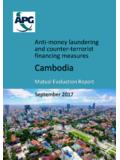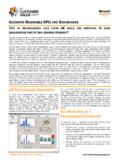Transcription of GUIDANCE FOR A RISK BASED-APPROACH - fatf …
1 GUIDANCE FOR A RISK-BASED APPROACH. PREPAID CARDS, MOBILE PAYMENTS AND. INTERNET-BASED PAYMENT. SERVICES. June 2013. FINANCIAL ACTION TASK FORCE. The Financial Action Task Force (FATF) is an independent inter-governmental body that develops and promotes policies to protect the global financial system against money laundering, terrorist financing and the financing of proliferation of weapons of mass destruction. The FATF Recommendations are recognised as the global anti-money laundering (AML) and counter-terrorist financing (CFT) standard. For more information about the FATF, please visit the website: 2013 FATF/OECD. All rights reserved. No reproduction or translation of this publication may be made without prior written permission.
2 Applications for such permission, for all or part of this publication, should be made to the FATF Secretariat, 2 rue Andr Pascal 75775 Paris Cedex 16, France (fax: +33 1 44 30 61 37 or e-mail: GUIDANCE FOR A RISK BASED-APPROACH . PREPAID CARDS, MOBILE PAYMENTS AND INTERNET-BASED PAYMENT SERVICES. CONTENTS. ACRONYMS .. 2. I. 3. A. Scope and target audience .. 3. B. Purpose of the GUIDANCE .. 4. II. ROLE OF ENTITIES INVOLVED IN THE PROVISION OF NPPS .. 5. A. Prepaid cards .. 5. B. Mobile payments .. 6. C. Internet-based payment services .. 9. III ENTITIES COVERED BY THE FATF RECOMMENDATIONS .. 11. A. FATF definition of financial institutions .. 11. B. Possible risk-based exemption from AML/CFT measures .. 13.)
3 IV. RISK ASSESSMENT AND RISK MITIGATION OF NPPS .. 13. A. Risk factors .. 14. B. Risk mitigation measures .. 21. V. IMPACT OF REGULATION ON THE NPPS 25. A. FATF GUIDANCE on financial inclusion .. 25. B. G20 Principles for innovative financial inclusion .. 26. VI. REGULATION, SUPERVISION & THE RISK-BASED APPROACH .. 26. A. Risk-based approach to AML/CFT measures and supervision .. 26. B. Customer due diligence .. 27. C. Licensing / 30. D. Wire transfers .. 30. E. Supervisory approach and identification of the competent jurisdiction .. 31. VII. APPROPRIATE AML/CFT REGULATION WHICH ADDRESSES THE RISKS .. 33. A. Level of AML/CFT measures proportional to the level of risk .. 33. B. Issues to consider when determining the NPPS provider subject to AML/CFT.
4 34. ANNEX 1 REGULATORY APPROACHES FOR NPPS .. 37. BIBLIOGRAPHY .. 45. 2013 1. GUIDANCE FOR A RISK BASED-APPROACH . PREPAID CARDS, MOBILE PAYMENTS AND INTERNET-BASED PAYMENT SERVICES. ACRONYMS. AML/CFT Anti-money laundering and countering the financing of terrorism ATM Automated teller machine CDD Customer due diligence G2P Government-to-person IP Internet protocol KYC Know your customer ML Money laundering MNO Mobile network operators MVTS Money or value transfer services NFC Near field communication NPM New payment methods NPPS New payment products and services P2B Person-to-business P2P Person-to-person POS Point of sale RBA Risk-based approach SIM Subscriber identity module TF Terrorist financing USSD Unstructured supplementary service data 2 2013.
5 GUIDANCE FOR A RISK BASED-APPROACH . PREPAID CARDS, MOBILE PAYMENTS AND INTERNET-BASED PAYMENT SERVICES. GUIDANCE FOR A RISK-BASED APPROACH TO PREPAID CARDS, MOBILE. PAYMENTS AND INTERNET-BASED PAYMENT SERVICES. I. INTRODUCTION. 1. The rapid development, increased functionality, and growing use of new payment products and services (NPPS) globally has created challenges for countries and private sector institutions in ensuring that these products and services are not misused for money laundering (ML) and terrorist financing (TF) purposes. This has attracted the attention of anti-money laundering and countering the financing of terrorism (AML/CFT) authorities as they seek to develop and implement AML/CFT. regulation for NPPS.
6 The Financial Action Task Force (FATF) issued typologies reports1 in 2006, 2008 and 2010 on new payment methods (NPM) which focused on: the potential for NPM to be misused by criminals; the identification of risk factors which can significantly differ from one new payment product or service to another, depending on functionality; and risk mitigants which can be tailored to a particular new payment product or service to address its specific risk profile. The FATF. recognises the innovative use of emerging technologies in this area, including decentralised digital currencies. The FATF's discussion reflects these concerns and will continue to consider the risks and measures necessary to mitigate ML/TF risks posed by these.
7 A. SCOPE AND TARGET AUDIENCE. 2. This paper proposes GUIDANCE on the risk-based approach to AML/CFT measures and regulation in relation to NPPS of prepaid cards, mobile payments and Internet-based payment services, in line with the FATF Recommendations. The GUIDANCE is non-binding and does not override the purview of national authorities. The intention is to build on the FATF typologies reports and to complement existing FATF GUIDANCE relating to the development and implementation of a risk- based approach to AML/CFT, including in particular the FATF GUIDANCE on ML/TF risk NPPS also play an important role in financial inclusion. This GUIDANCE is in line with the FATF. GUIDANCE on anti-money laundering and terrorist financing measures and financial inclusion, which supports countries and financial institutions in designing AML/CFT measures that meet the national goal of financial inclusion, without compromising the measures that exist for the purpose of combating In this respect, the FATF recognises that applying an overly cautious approach to AML/CFT safeguards can have the unintended consequence of excluding legitimate businesses and consumers from the financial system, thereby compelling them to use services that are not subject to regulatory and supervisory oversight.
8 AML/CFT controls must not inhibit access to formal financial services for financially excluded and unbanked persons. The FATF recognises that financial 1 See FATF (2006), FATF (2008) and FATF (2010). 2 See FATF (2013a). This document outlines general principles that may serve as a useful framework in assessing ML/TF risks at the national level. However, these principles may also relevant when conducting risk assessments of a more focussed scope. The GUIDANCE is also not intended to describe how supervisors should assess risks in the context of risk-based supervision. 3 See FATF (2013b). 2013 3. GUIDANCE FOR A RISK BASED-APPROACH . PREPAID CARDS, MOBILE PAYMENTS AND INTERNET-BASED PAYMENT SERVICES. exclusion could undermine the effectiveness of an AML/CFT regime hence, financial inclusion and AML/CFT should be seen as serving complementary objectives.
9 3. For the purposes of this GUIDANCE , NPPS are considered to be new and innovative payment products and services that offer an alternative to traditional financial services. NPPS include a variety of products and services that involve new ways of initiating payments through, or extending the reach of, traditional retail electronic payment systems, as well as products that do not rely on traditional systems to transfer value between individuals or organisations. Given the rapid development and changing nature of such products and services, any attempt to more precisely define what is meant by NPPS will likely unintentionally limit the applicability of this GUIDANCE paper. In this respect, it is important to recognize that while this GUIDANCE focuses on existing NPPS, it may equally apply to new and emerging NPPS not considered in this paper.
10 To ensure that the GUIDANCE in this paper is relevant and practical, it will focus particularly on three categories of NPPS: (1) Prepaid cards; (2) Mobile payment services; and (3) Internet-based payment services. It is important to note that NPPS are increasingly interconnected, both between these three categories and with traditional payment methods. 4. Traditional financial services, such as banking services, are increasingly offered through new and innovative methods, including using the Internet or mobile phone technology. However, while countries and financial institutions should identify and assess the ML/TF risks that may arise in relation to new delivery methods of these traditional financial services4, they do not fall within the scope of this GUIDANCE .















